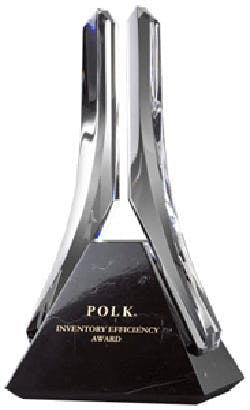Like this article? Sign up for our enews blasts here.
That type of data integration is something you can expect to see more of in the aftermarket, says Bryan Funke, director of sales and client services at Polk. According to Funke, in the past, award submissions have focused on stocking or assortment planning, or ways to increase coverage without increasing the number of parts in the store. "Now we're seeing companies leverage many different data sources, get that information out to the field and across the whole organization so everybody is looking at the same thing," Funke says. "We're seeing true integration of the data.
"The two winners this year showed such a huge business impact that it really set them apart," Funke added. "The committee was impressed with the complexity of the businesses, and how flawlessly they implemented these solutions across the business."
Timken tackles category management
Canton, Ohio-based Timken was recognized in the Manufacturer category for an enterprise-wide software upgrade involving new enterprise resource planning (ERP), warehouse and logistics management improvements, and increased supply chain efficiencies. The result: the company improved year-over-year sales by 19 percent, reduced inventory 12 percent and increased order fill rates by 13 percent.
"They can see everything about the business, from the product lines to stock on hand to sales," Funke says. "They were able to take that and improve asset utilization and change their logistics network to help reduce costs and increase fill rates."
Timken began deploying the new SAP ERP solution nearly five years ago, which provided more robust supply chain visibility. In 2010, the company launched its Demand Insight category management tool (which was built in house). According to Tom Tecklenburg, global aftermarket director at Timken, the company had to address the complexity of matching vehicles, catalog data and vehicles in operation data by region, and then integrating that with customer data files based on POS information to create forecasts.
"It's been an ongoing evolution since then," Tecklenburg says. "What's been key is the user feedback we've gotten. The team is constantly doing updates on different phases of the project and talking with key users that are really interested in this and see the value to their business."
With the new ERP system in place, Timken was able to boost its category management operations to identify new business opportunities, and help distributors boost sales via highly local inventory management processes. The company added 134 new customers in 2011, and plans to expand the system's availability outside the U.S.
The company's customers are fully onboard, Tecklenburg says, because by sharing accurate data about their own sales and customer base, the tool can provide much more accurate and specific forecasts. "We all benefit from reducing the cost of doing business," Tecklenburg says. 'If we're using the tool to evaluate their inventory, we can make sure they have the right inventory out there for the new models. That reduces returns and makes the whole process more efficient."
Alliance focuses on inventory visibility to boost sales
The Aftermarket Auto Parts Alliance, which won the Retailer/Distributor category, was able to leverage its master Data Warehouse to enable the new Alliance Technology Suite. The inventory optimization and e-commerce tools have been deployed across its 53 warehouse distributorships to improve inventory management.
When the Alliance originally set up its centralized solution, the goals were to make sure the right parts were on the shelf at the right time; to make sure every part anywhere in the supply chain could be looked up electronically; and to allow the parts to be purchased online via an e-commerce solution 24 hours a day.
According to Dale Hopkins, chief information officer at the Alliance, there are three key components to the Alliance Technology Suite. First, the Alliance Inventory Optimization Tool utilizes regional and local sales and inventory data, VIO data and other information to create customizable stocking plans. The Alliance also developed the Supplies, Accessories and Tools catalog, which operates as a portal in tandem with application e-catalogs and third-party POS systems so that jobbers and installers can look up non-application parts. "This eCat includes not only supplies and tools, but also many parts for small engines, marine, heavy duty vehicles and more," Hopkins says.
The third element is MyPlaceForParts, the company's e-commerce solution.
Everything rests on the Alliance Data Warehouse and Business Intelligence Solution, which is based on industry data standards (ACES, PIES, IP) and the AWDA flat file communication standard. Hopkins says it took roughly 24 to 30 months to deploy the new solution suite. Adoption was voluntary for members, but "when we explained what the tools are and the benefit to he members, it was gangbusters," Hopkins says. "We rolled out a new Alliance member every seven to 10 days. It was very intense."
According to the company, the technology enabled a 4.7 percent incremental sales increase (over and above the organic growth of the control group), and the redeployment of $38 million in inventory.
Although the creation and implementation of this type of system required a lot of commitment in terms of time, resources and financing, Hopkins credits the Alliance's board for fully backing the investment. "Oftentimes, a board of directors will pull the trigger on a project like this and then get cold feet halfway through and scale it down," Hopkins says. "The Alliance board of directors pushed this project full steam ahead, and they had the vision to support it.


